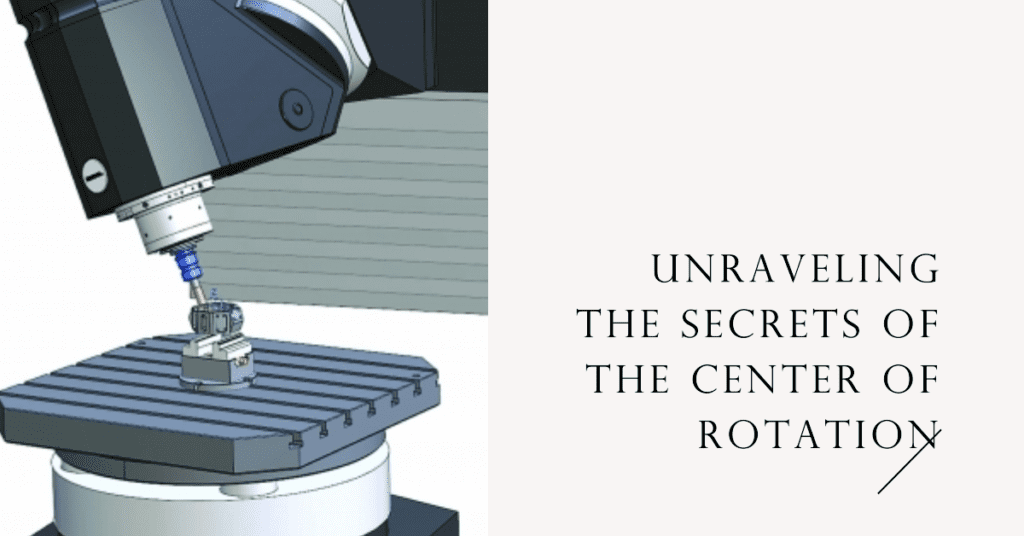
The center of rotation is a term that finds its applications in various fields including mathematics, physics, and engineering. It is a point around which an object rotates or revolves. Understanding this concept is pivotal in operations involving rotating machinery and tools, especially in CNC machining. Efficiently determining the rotation center of the rotary when operating a 4-axis machine is crucial for ensuring the precision and quality of the machined parts.
This article will shed light on the center of rotation, methods and tools to determine it, and its significance in various applications, especially in CNC machining.
What is the Center of Rotation?
The center of rotation is a foundational concept in several fields, including but not limited to mathematics, physics, and engineering. In essence, it refers to a specific point around which an object, shape, or line rotates. This point remains stationary while every other point of the object or shape moves around it in a circular path. It is fundamental to understand and accurately identify the center of rotation, as it is pivotal for optimizing the performance and efficiency of rotating machinery and tools.
Center of Rotation in Engineering & CNC Machining
In engineering, especially in fields involving machinery and mechanical systems, the center of rotation plays a vital role. For instance, in automotive engineering, the center of rotation is a crucial concept for the design and operation of vehicles. It impacts the vehicle’s handling characteristics, such as its stability and maneuverability. Moreover, in robotics, the center of rotation is fundamental for the design and operation of robotic arms and joints. Accurate determination of the center of rotation is essential for the precise movement and operation of robots.
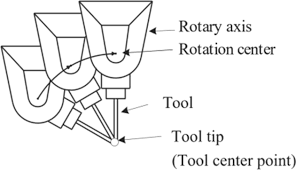
Rotation center of machining tool
In the context of CNC machining, the center of rotation is crucial for the operation of rotary tables and machine tools. A CNC machine with a rotary table allows workpieces to be rotated, typically around a horizontal or vertical axis, enabling the machining of complex parts with high precision. The center of rotation of the rotary table must be accurately determined to ensure that the workpiece is correctly aligned with the machine’s tools. This alignment is essential for producing parts with high accuracy and precision.
Key Characteristics of the Center of Rotation:
- Fixed Point: The center of rotation is a fixed point that does not move while the rest of the points of an object or shape rotate around it.
- Circular Path: Every point of the object or shape, except for the center of rotation, moves in a circular path around the center.
- Angle of Rotation: The amount of rotation is usually described in degrees. For example, a 90-degree rotation will move a point to a new position that is 90 degrees counterclockwise from its starting position.
Why Center of Rotation Matters in CNC Machining?
The center of rotation is a pivotal aspect of CNC machining that often doesn’t get the attention it deserves. However, its significance cannot be overstated. It refers to the point around which a body or an object rotates. In the context of CNC machining, it is the point around which the rotary table or a workpiece rotates. This is crucial for several reasons, some of which are detailed below.
Precision and Accuracy
Precision and accuracy are of utmost importance in CNC machining. Even the slightest deviation from the intended path can lead to defective parts. The center of rotation plays a critical role in ensuring that the workpiece is machined accurately. If the center of rotation is not correctly set, it can lead to errors in the final product. For example, a hole that is supposed to be circular may end up being elliptical.
- Ensures Correct Geometry: The geometry of the final product is highly dependent on the center of rotation. If the center of rotation is off, even by a small amount, it can lead to incorrect geometries. This is particularly important for complex parts with intricate geometries.
- Minimizes Scrap: Incorrect center of rotation can lead to the production of defective parts which ultimately results in waste. By ensuring that the center of rotation is correct, it helps in minimizing scrap.
Consistency in Production
In mass production, consistency is key. It is important that each part produced is identical to the others. Any variation in the center of rotation can lead to inconsistencies in the final product.
- Ensures Repeatability: Repeatability refers to the ability of the CNC machine to produce the same part multiple times with minimal variation. The correct center of rotation ensures that the machine can produce identical parts consistently.
- Reduces Rework: Incorrect parts need to be reworked or remanufactured, which adds to the cost and time. Correct center of rotation reduces the need for rework as it ensures that the parts are manufactured correctly the first time.
Enhances Tool Life
The life of the cutting tools used in CNC machining is affected by the center of rotation. If the center of rotation is incorrect, it can lead to uneven wear on the tools, reducing their life.
- Reduces Tool Wear: Correct center of rotation ensures that the cutting forces are distributed evenly across the tool, reducing wear and increasing tool life.
- Minimizes Tool Breakage: Incorrect center of rotation can lead to excessive forces on the tool, increasing the risk of tool breakage.
Cost Savings
Ultimately, the correct center of rotation leads to cost savings. It minimizes scrap, reduces rework, and increases tool life, all of which contribute to reducing the overall cost of production.
- Minimizes Material Waste: Material is expensive, and minimizing waste is crucial for cost savings. Correct center of rotation ensures that the parts are manufactured correctly, minimizing material waste.
- Reduces Machine Downtime: Machine downtime is costly. Incorrect center of rotation can lead to tool breakage, which requires the machine to be stopped for tool replacement. This downtime can be minimized by ensuring the correct center of rotation.
Tools to Determine the Rotation Center
Determining the rotation center of a rotary table in a CNC machine is crucial for the success of any machining operation. Various tools can be used for this purpose, each with its own set of advantages and limitations. These tools range from simple visual inspection tools to advanced laser measurement systems.
Visual Inspection Tools
Visual inspection tools are the most basic tools used for determining the center of rotation. These tools include straight edges, rulers, and protractors. Although these tools are not as accurate as some other options, they can provide a preliminary estimation of the center of rotation, which can be useful for initial setup or troubleshooting.
For example, a straight edge can be placed against the rotary table, and its alignment with a fixed point on the machine can be checked as the table rotates. Any deviation from the straight edge’s alignment indicates that the center of rotation is not correctly set. Similarly, a protractor can be used to measure the angle of rotation and compare it with the expected value. Any discrepancies can indicate a problem with the center of rotation.
Table: Visual inspection method for rotation center measurement
| Step | Description |
|---|---|
| 1 | Select the appropriate tool (straight edge, ruler, or protractor) based on the initial setup or troubleshooting required. |
| 2 | Align the tool with a fixed point on the machine and the rotary table. |
| 3 | Rotate the table and check for any deviation from the alignment of the tool. |
| 4 | Adjust the center of rotation if any discrepancies are observed. |
Dial Indicators
Dial indicators are precision measurement tools that can be used to determine the center of rotation with high accuracy. They work by measuring the deviation of the rotary table as it rotates. A dial indicator is usually mounted on the spindle of the CNC machine, and the tip of the indicator is placed against the rotary table. As the table rotates, the dial indicator measures the deviation of the table from its expected position. This deviation indicates any misalignment of the center of rotation.
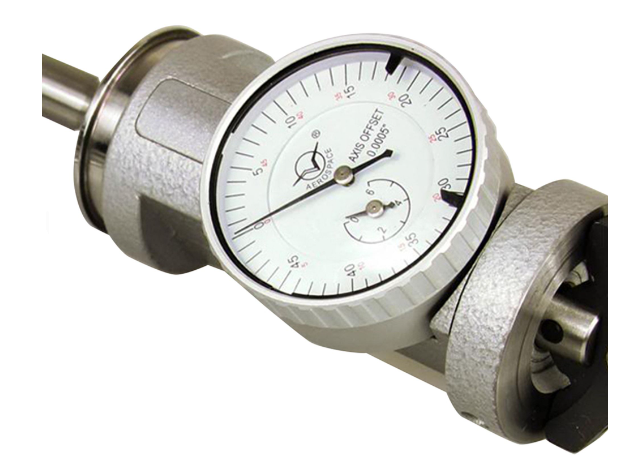
Co-axial dial indicator
There are different types of dial indicators available, each with its own set of features and specifications. Some common types include plunger dial indicators, lever-type dial indicators, and digital dial indicators. Plunger dial indicators have a plunger that moves in and out as the table rotates. Lever-type dial indicators have a lever arm that moves as the table rotates. Digital dial indicators display the measurements digitally, making it easier to read and record the data.
Table: Dial indicators method for rotation center measurement
| Step | Description |
|---|---|
| 1 | Select the appropriate type of dial indicator (plunger, lever-type, or digital) based on the requirements of the machining operation. |
| 2 | Mount the dial indicator on the spindle of the CNC machine. |
| 3 | Place the tip of the indicator against the rotary table. |
| 4 | Rotate the table and observe the deviation measured by the dial indicator. |
| 5 | Adjust the center of rotation based on the measurements. |
Laser Measurement Systems
Laser measurement systems are advanced tools that use lasers and sensors to determine the center of rotation with high precision. These systems typically consist of a laser transmitter, a receiver, and a display unit. The laser transmitter emits a laser beam, which is reflected by a mirror mounted on the rotary table. The receiver detects the reflected laser beam, and the display unit shows the measurements.
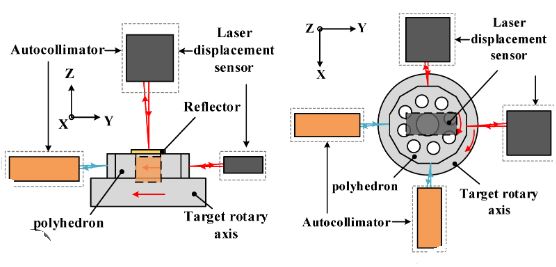
Laser measurement and analysis
The advantage of laser measurement systems is that they can provide very high levels of accuracy, often up to a few micrometers. They are also fast and can measure the center of rotation in real-time. This makes them suitable for high-precision applications where accuracy is critical.
Table: Laser system for rotation center measurement
| Step | Description |
|---|---|
| 1 | Set up the laser measurement system by positioning the laser transmitter, receiver, and display unit. |
| 2 | Mount a mirror on the rotary table to reflect the laser beam. |
| 3 | Turn on the laser transmitter and align the laser beam with the mirror and receiver. |
| 4 | Rotate the table and observe the measurements on the display unit. |
| 5 | Adjust the center of rotation based on the measurements. |
Determining the Rotation Center of Rotary When Operating 4-Axis Machine
In CNC machining, the 4-axis machine is a piece of essential equipment that allows workpieces to be manipulated and machined with high precision. The ‘4-axis’ refers to the number of directions in which the cutting tool or the workpiece can move. The standard axes are X, Y, and Z, with the fourth axis being the rotational axis around one of the other axes.
The center of rotation plays a critical role in 4-axis machining as it impacts the accuracy and quality of the final product. Determining the rotation center of the rotary table when operating a 4-axis machine is, therefore, a crucial task.
1. Understanding the 4-Axis Machine
Before diving into the process of determining the rotation center, it is crucial to have a solid understanding of the 4-axis machine. A 4-axis CNC machine operates on the X, Y, Z, and one rotational axis. This additional axis allows for more complex shapes and angles to be machined, which is not possible with a 3-axis machine. The 4-axis machine can either rotate the workpiece or the cutting tool, depending on the setup.
2. Importance of the Rotation Center
The rotation center of the rotary table or the cutting tool is a pivotal point that significantly impacts the machining process. An accurately determined rotation center ensures that the workpiece or tool rotates correctly, leading to high-precision machining. Any misalignment or error in determining the rotation center can lead to inaccuracies in the final product, wasted materials, and increased production time. Thus, accurately determining the rotation center is crucial for efficient and high-quality machining.
3. Preparing the Machine
Before starting the process of determining the rotation center, it is essential to prepare the machine properly. This involves ensuring that the machine is clean, free of any debris, and that all its components are in good working order. Additionally, the machine should be leveled, and the spindle and table should be aligned correctly. All these steps are crucial for ensuring accurate determination of the rotation center.
4. Setting Up the Workpiece or Tool
Next, the workpiece or tool needs to be set up correctly on the machine. It is crucial to ensure that the workpiece or tool is securely fastened and aligned correctly. Any misalignment at this stage can lead to inaccuracies in the final product. Additionally, it is essential to ensure that the workpiece or tool is centered as accurately as possible. This can be done using a variety of methods, such as using a dial indicator or a laser alignment tool.
Determining the Rotation Center
Once the machine and the workpiece or tool are set up correctly, the process of determining the rotation center can begin. There are several methods to determine the rotation center, and the choice of method depends on the level of accuracy required and the available resources. Some common methods include:
- Mathematical Calculation: This involves using mathematical equations and geometric principles to determine the rotation center. For example, in a circular workpiece, the geometric center of the workpiece can be calculated mathematically.
- Using Measurement Tools: Tools like dial indicators, laser measurement systems, or touch probes can be used to determine the rotation center. For example, a dial indicator mounted on the spindle can be used to measure the deviation of the table as it rotates.
- Computer-Aided Design (CAD) Software: CAD software can be used to create a virtual model of the workpiece or tool and simulate its rotation to determine the rotation center accurately.
Each method has its advantages and disadvantages, and the choice of method depends on the specific requirements of the machining process.
Verifying the Rotation Center
After determining the rotation center, it is crucial to verify its accuracy. This can be done by rotating the workpiece or tool and checking if it rotates correctly and without any wobbling or deviations. Any inaccuracies in the rotation center can lead to errors in the final product, so it is essential to verify the rotation center’s accuracy before starting the machining process.
Once the rotation center is determined and verified, any necessary adjustments to the machine can be made. This may involve adjusting the position of the workpiece or tool, the machine settings, or the program that controls the machine. It is crucial to ensure that all adjustments are made accurately and that the machine is correctly calibrated before starting the machining process.
Summing Up
The center of rotation is a pivotal concept in various fields, especially in CNC machining. Accurately determining the center of rotation of the rotary when operating a 4-axis machine is crucial for ensuring the precision, efficiency, and safety of the operation. Various methods and tools, ranging from simple visual inspection to advanced laser measurement systems, can be employed to determine the center of rotation. Ultimately, choosing the right method and tool depends on the level of accuracy required and the available resources.
Prolean’s CNC machining services are designed to help you achieve the highest level of precision and efficiency in your operations. Our team of experienced engineers and machinists is equipped with the latest tools and knowledge to ensure that your machined parts are of the highest quality. Contact us today to learn more about how we can help you optimize your CNC machining operations.
FAQs
What is the center of rotation?
The center of rotation is a fixed point around which a shape or an object rotates. It is the point that remains unchanged while the rest of the points of an object rotate around it.
How can I determine the center of rotation of the rotary table in a CNC machine?
Various methods and tools can be employed to determine the center of rotation of the rotary table, including visual inspection, using a dial indicator, and using a laser measurement system.
Why is it important to accurately determine the center of rotation?
Accurately determining the center of rotation is essential for ensuring the precision and efficiency of the operation. It also helps in minimizing wear and tear on the machinery and tools, thus extending their lifespan.
Can I determine the center of rotation visually?
While it is possible to estimate the center of rotation visually, it is not the most accurate method. It is usually employed as a preliminary step before using more accurate methods like using a dial indicator or a laser measurement system.
What are the most accurate tools for determining the center of rotation?
Dial indicators and laser measurement systems are the most accurate tools for determining the center of rotation.

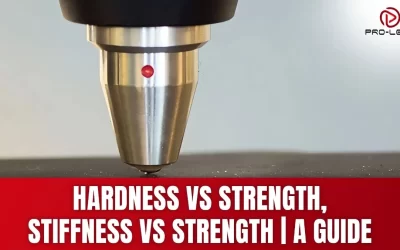


0 Comments